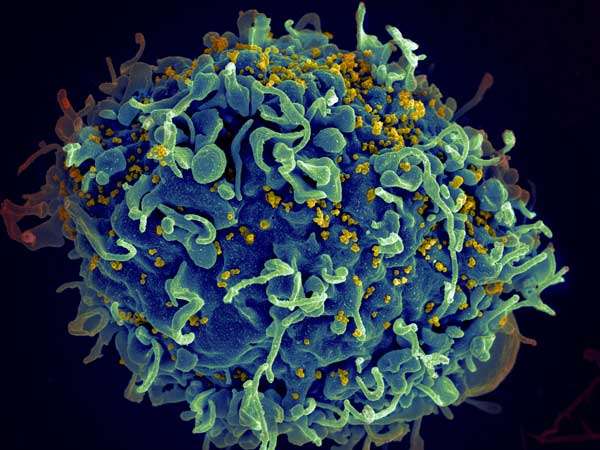Botswana study shows 96 percent rate of viral suppression for patients on HIV drugs

Botswana appears to have achieved very high rates of HIV diagnosis, treatment, and viral suppression—much better than most Western nations, including the United States—according to a new study from Harvard T.H. Chan School of Public Health and colleagues in Botswana. The findings suggest that even in countries with limited resources where a large percentage of the population is infected with HIV, strong treatment programs can help make significant headway against the HIV/AIDS epidemic.
The study will be published online March 23, 2016 in The Lancet HIV.
"By now, we hoped to have an HIV vaccine. That hasn't happened. Ironically, treatment of HIV-infected persons may be our most effective, efficient way to prevent new infections. These results show that Botswana has made great progress in reducing the number of people who are infectious to others," said Max Essex, Mary Woodard Lasker Professor of Health Sciences, chair of the Harvard T.H. Chan School of Public Health AIDS Initiative, and chair of the Botswana Harvard AIDS Institute Partnership.
Global HIV programs have continued to face challenges in achieving the high rates of testing and treatment needed to optimize health and reduce new infections. Mounting evidence suggests that providing antiretroviral treatment (ART) to all people living with HIV, regardless of the stage of their disease, can help. In 2014, the Joint United Nations Programme on HIV/AIDS (UNAIDS) proposed new testing and treatment targets: that 90% of all people living with HIV know their HIV status; that 90% diagnosed with HIV be given ART; and that 90% who receive treatment have virologic suppression—very low blood levels of HIV—by the year 2020.
The researchers looked at the achievability of the UNAIDS targets in Botswana—a middle-income African nation where 25% of the population aged 15-49 is HIV positive but which also has a mature public ART program—by directly measuring HIV status, treatment, and viral suppression among 12,610 people from 30 communities across the country between October 2013 and November 2015. Study participants were drawn from a large, ongoing HIV prevention study in Botswana. The participants responded to a questionnaire, had their blood tested for HIV if their status wasn't known, and, if they were infected with HIV, their viral load was checked.
Out of the 12,610 participants, 3,596 (29%) were HIV infected and 2,995 (83.3%) of these individuals already knew their HIV status. Among those who knew their status, 2,617 (87.4%) were receiving ART.
Significantly, the study authors called it "remarkable" that of the 2,609 people receiving ART who had their viral load checked, 2,517 (96.5%) had viral suppression.
Until now, there has been considerable uncertainty as to whether the ambitious targets proposed by UNAIDS can be achieved, especially in countries with limited resources where the HIV burden is highest, according to the study authors. But the new findings suggest that Botswana could meet and even exceed the targets well before 2020, especially if ART eligibility is expanded—and that other countries could do the same.
"This is significant work as it provides further evidence that the UNAIDS 90-90-90 treatment target is both realistic and achievable," said UNAIDS Executive Director Michel Sidibé, who was not involved in the study.
Lead author of the study was Tendani Gaolathe of the Botswana Harvard AIDS Institute Partnership. Other Harvard Chan School authors of the study included Kathleen Wirth, Molly Pretorius Holme, Joseph Makhema, Quanhong Lei, Vlad Novitsky, Kathleen Powis, Nealia Khan, Hermann Bussmann, Scott Dryden-Peterson, Rui Wang, Eric Tchetgen Tchetgen, Victor DeGruttola, and Shahin Lockman.
Funding came from The United States President's Emergency Plan for AIDS Relief (PEPFAR) through the Centers for Disease Control and Prevention under the terms of cooperative agreement U01 GH000447.
More information: "Botswana's Progress Toward Achieving the 2020 UNAIDS 90-90-90 Antiretroviral Treatment and Virologic Suppression Goals: Results of a Population-Based Survey," Tendani Gaolathe, Kathleen E. Wirth, Molly Pretorius Holme, Joseph Makhema, Sikhulile Moyo, Unoda Chakalisa, Etienne Kadima Yankinda, Quanhong Lei, Mompati Mmalane, Vlad Novitsky, Lillian Okui, Erik van Widenfelt, Kathleen M. Powis, Nealia Khan, Kara Bennett, Hermann Bussmann, Scott Dryden-Peterson, Refeletswe Lebelonyane, Shenaaz el-Halabi, Lisa A. Mills, Tafireyi Marukutira, Rui Wang, Eric J. Tchetgen Tchetgen, Victor DeGruttola, M. Essex, Shahin Lockman, and the BCPP study team, Lancet HIV, March 23, 2016, DOI: 10.1016/S2352-3018(16)00037-0
















